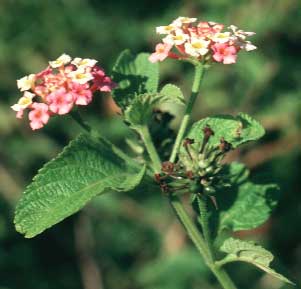Centre for Plant Biodiversity Research
|

|
Centre for Plant Biodiversity Research
|

|
 Background:
Background:Lantana camara is regarded as one of the ten worst weedy species invading pasture lands and natural communities in the South Pacific and Australia. Control measures have included the use of chemical sprays and the deployment of biological control agents. However, despite a massive effort involving many countries and the release of more than 30 insect species, control has been spotty and unpredictable, ranging from none to significant in some countries (Swarbrick et al. 1998). The main reason for this overall lack of success has been ascribed to the extreme variability of the plant coupled with its colonizing ability. To date various studies of variation in Lantana have been carried out (most notably Munir 1996; Stirton 1999). However, early studies in Australia based primarily on flower color morphs have been found to be unreliable. Moreover, this character has shown very little correlation with preliminary studies of underlying molecular variation assessed using RAPD markers (Scott et al. 1997; Scott 1998).
Two "species" of Lantana L. are known to occur in Australia: L. camara L. and L. montevidensis (Spreng.) Briq (Munir 1996). The origin of the first species is unknown. It is most likely to be a hybrid of several South American species. This hybrid complex was probably created in the 19th century by gardeners and horticulturists and introduced by them in Australia (Smith & Smith 1982; Stirton, 1999). This hybrid origin would explain the great morphological variability within this "species" and the complex chromosome structure.
The genus was introduced into Australia as early as 1841 and numerous introductions have been made since then. It is interesting to note that several other species of Lantana were introduced apart from the two now present. Of these two species Lantana montevidensis has created the least trouble. It now occurs in Eastern Queensland and New South Wales but seems to be less weedy and invasive than L. camara. Lantana camara on the other hand, now occurs abundantly and widespread in Eastern Queensland and New South Wales and the northern part of the Northern Territory, and in some patches around Perth, Melbourne and Adelaide (Munir 1996).
Lantana camara sensu lato is a polyploid aggregate species complex with the base chromosome numbers of x=11 and 12. Each base number has a range of diploid, triploid, tetraploid, pentaploid and hexaploid representatives (Stirton 1999 and references there in). In its native range there is a strong correlation between chromosome number and morphology. This correlation is absent in all areas where this species has been introduced. There are strong cytological differences between the native taxa in South America and the introduced taxa in Southern Africa, with the later having meiotic irregularities in the diploids. This could be relevant to the Australian representatives as most forms were probably introduced via South Africa (Stirton 1978).
The name L. camara is a name of convenience, which was given to the specimens of this complex occurring in Australia, the Pacific and Southern Africa. Its actual status and its relationship with the real L. camara in South America needs to be addressed as part of an examination of the whole genus. One of the more theoretical aspects of this work will be to examine the status of L. camara as a taxon. If this taxon was artificially created in the 19th century as some authors propose, its status as an entity would then be different (conservation and ethics wise), from the 'natural' species in the genus. These theoretical problems of artificially created 'taxa' will become more acute in the future.
Due to its morphological variation and it occurrence all over the warmer parts of the world many different names have been reported for various forms of L. camara. At least 650 cultivar names are known of this species and in Australia alone 29 forms were recognized (Smith & Smith 1982). It was reported that some of these forms were more weedy than others. However, it has proven to be very difficult to recognize most of these forms in the field and so called "throw-backs" - one form spontaneously reverting into another - have been frequently reported. Most of the characters used to delimit these forms like: habit, flower colour, presence and number of spines and the length of internodes are known to be very variable and are also characters linked to a weedy life cycle (Swarbrick et al. 1998). These morphological characters are therefore problematic for recognizing sub-divisions within this species complex, both in practical and more evolutionary terms.
In Australia, Lantana camara has been the target of many biological control attempts. These have had only limited success. If Lantana camara as found in Australia has as complex a history as some authors proposed, then it is likely that the 'taxon' would have a more complex response to biocontrol agents than Lantana camara sensu stricto would have in its native range. A better understanding of the genetic makeup and background of Lantana camara in Australia should be an important tool in the selecting and testing of biocontol agents. Furthermore, it would be valuable to look retrospectively at the history of the introduction of the biocontrol agents and compare any selective effectiveness with the results of the molecular work.
Lantana is part of the Verbenaceae and forms part of the Lantaneae subdivision of that family. Recent analysis, based on both molecular and morphological data, placed most traditional members of the Verbenaceae into the closely related family Labiatae (see Cantino 1992; Olmstead et al. 2001). However, Lantana together with a small number of other genera has remained in the Verbenaceae. This shift means that there are almost no native members of the Verbenaceae in Australia. Lantana is closely related to the European and American genera Verbena and Stachytarpheta and more distally to the members of the families Bignoniaceae, Acanthaceae and the now expanded Labiatae. At present the genus contains seven species, six from South America and one from Ethiopia (Munir 1996).
The thrust of this project will be to assess variation and relationships within and among taxa at a series of evolutionary levels from the individual population to the genus and its position in the Verbenaceae. A combination of molecular and morphological approaches will be used. Molecular characters will be chosen with particular questions in mind and are likely to range from microsatellites (within and among population variation) through to sequencing of both nuclear and chloroplast genes. Questions to address will include:
This project will integrate both morphological and molecular approaches to provide a clear picture of variation in this weedy species, the way this variation is distributed among populations, and evolutionary relationships in the genus as a whole. This information will be a valuable tool for weed biologists guiding the use of future biological control approaches.
Cantino, P.D. (1992) Evidence for a polyphyletic origin of the Labiatae. Ann. Missouri Bot. Gard. 79: 361-379.
Munir, A.A. (1996) A taxonomic review of Lantana camara L. and L. montevidensis (Spreng.) Briq. (Verbenaceae) in Australia. J. Adelaide Bot. Gard. 17: 1-27.
Olmstead, R.G., DePamphilis, C.W., Wolfe, A.D., Young, N.D., Elisons, W.J. & Reeves, P.A. (2001) Disintegration of the Scrophulariaceae. Am. J. Bot. 88: 348-361.
Scott, L. (1998). Identification of Lantana spp.. Taxa in Australia and the South Pacific. Final Report to ACIAR, Project 7601.
Scott, L.J., Graham, G.C., Hannan-Jones, M & Yeates, D.K. (1997). DNA profiling resolves the limited importance of flower colour in defining varieties of Lantana camara. Electrophoresis 18: 1560-1563.
Smith, L.S. & Smith, D.A. (1982). The naturalised Lantana camara complex in eastern Australia. Qld. Bot. Bull. 1: 1-26.
Stirton, H.S. (1999). The naturalized Lantana camara L. (Lantaneae-Verbenaceae) complex in Kwazulu-Natal, South Africa, A dilemma for the culton concept. In: S. Andrews, A.C. Leslie and G. Alexander (eds.). Taxonomy of Cultivated Plants pp 311-324. Royal Botanic Gardens, Kew.
Swarbrick, J.T., Willson, B.W., Hannan-Jones, M.A. (1998) Lantana camara L. In: Biology of Australian Weeds 2, Panetta, F.D., Groves, R.H. & Shepherd, R.C.H. (eds), pp. 119-140. Richardson, Melbourne.
|
Dr Rogier de Kok, Centre for Plant Biodiversity Research, |
Phone: (02) 6246 5177 |
Find out more about the Cooperative Research Centre for Weed Management Systems